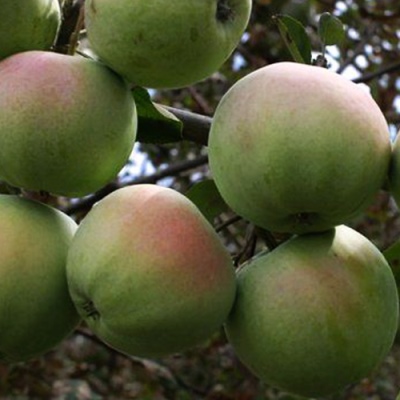
- Authors: M. M. Ulyanishchev (Rossoshan fruit and berry station)
- Taste: bright sour-sweet, dessert
- Fruit weight, g: 200
- Yield: at the age of 13-15 years harvest - 165 centners per hectare
- The beginning of fruiting varieties: for 6-7 years
- Ripening terms: winter
- Removable maturity: at the end of September
- Keeping quality: up to 6 months
- Appointment: universal
- Appeared when crossing: Mekintosh x Rossosh striped
Apple-tree April can present both pleasant and negative surprises. Therefore, its properties must be studied very carefully. There are no little things to ignore.
Breeding history of the variety
The Aprelskoe apple tree was created by employees of the Rossoshansk fruit and berry station in the Voronezh region. The project was directed by M. M. Ulyanishchev. The varieties Rossoshanskoe striped and Mekintosh were used as a base. It is curious that the development of 1938 was not immediately appreciated at its true worth. Only in 2019 this apple tree was revived, and since then it can be grown not only in a narrow circle of elite farms.
Description of the variety
Features, pros and cons
The height of the trunk can be 4-5 m. The crown of the apple tree resembles a tapering pyramid. Density for the top is not typical. April is characterized by strong, intensive growth. Problems are caused by the late formation of fetuses and the relatively high morbidity.
But this can be easily compensated for:
getting apples every season;
juiciness and decent taste of each copy;
significant total collection.
The variety needs moisture-absorbing, air-permeable soils. Best of all is loam and sandy loam. Areas may be sunny or partially shaded, but deep darkness is unacceptable. Seedlings with closed roots can be planted in almost any season. Plants with an open root system are preferably planted in the spring.
Ripening and fruiting
This is a representative of the medium-fruit category of apple trees. It will be possible to enjoy fruit from the tree at the 6-8 year of development. Not too fast, but they will turn out to be large and tasty. The stability of the collection is also encouraging. The removable ripeness of the fruit is reached by the end of September. The culture has no decorative properties.
Growing regions
You can successfully cultivate April's in:
Voronezh;
Kursk;
Lipetsk;
Belgorod;
Tambov regions.
Yield
Even despite the large size of apples, they are slightly larger in weight than other varieties in the same niche. This is quite a decent indicator. True, Antonovka will not be able to catch up anyway. Sometimes fruiting occurs on only 35-50% of the branches. This happens regardless of the weather, and the reasons have not yet been fully disclosed.
Fruits and their taste
April apples belong to the universal category. They are greenish yellow in color. An indistinct dark red blush is also noted. This effect only adds charm to the fruit. The geometry of apples is a full circle or a figure intermediate between a circle and a cone.
The average weight of one fruit is 200 g. They have a relatively thin peel with a smooth surface. The pulp is slightly greenish and oily. It is characterized by high density and fine-grained structure. April fruits are always juicy and pleasant.
Other important information:
keeping quality up to 180 days;
assessments by tasters from 4.2 to 4.5 points;
the concentration of sugars in the fruit is up to 10.6%;
concentration of titratable acids 0.42%;
the entry of ascorbic acid 13.3 mg (in terms of 100 g).

Growing features



Pollination
With all its practical advantages, the variety, alas, is self-fertile. Other trees should be planted within a radius of 50-150 m. The best pollinators for him are:
North Sinap;
original form Rossoshskoye Striped;
Cherry (but other types of apple can be tried; sugar syrup can also be useful to attract insects).
Top dressing
There is nothing unusual here compared to other varieties of apple trees. It is recommended to use:
compost;
superphosphate;
ammonium nitrate;
manure;
humus.

Frost resistance
April trees can survive cold temperatures down to -34 degrees. Therefore, the variety is deservedly among the leaders in terms of resistance in winter conditions. It is still advisable to cover the trunks with agrofibre, burlap and in other ways. At a young age, apple trees are protected by the standard method. It is already difficult to do this with adult specimens.


The apple tree is a popular fruit crop among gardeners. It can be found in many summer cottages. But at the same time, such trees are often affected by various diseases. It is very important to recognize the disease in time and carry out the necessary procedures for a speedy recovery. Otherwise, the fruits will be spoiled, and the tree itself may die altogether.












































































